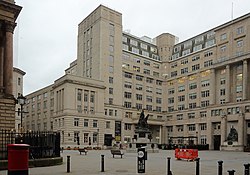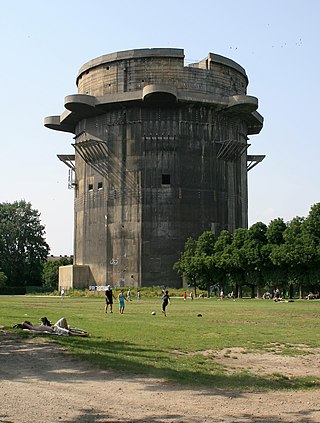
A bunker is a defensive military fortification designed to protect people and valued materials from falling bombs, artillery, or other attacks. Bunkers are almost always underground, in contrast to blockhouses which are mostly above ground. They were used extensively in World War I, World War II, and the Cold War for weapons facilities, command and control centers, and storage facilities. Bunkers can also be used as protection from tornadoes.

Guardian Exchange was an underground telephone exchange built in Manchester from 1954 to 1957. It was built together with the Anchor exchange in Birmingham and the Kingsway exchange in London – all believed to provide hardened communications in the event of nuclear war; as well as linking the UK government in London to the US Government in Washington, D.C. by means of a secure and hardened transatlantic telephone cable making landfall near Oban and running through Glasgow, Manchester and Birmingham. Today, the underground site is used for telephone cabling. Constructed at a depth of below 35 metres (115 ft), the tunnels are about 2 metres (80 in) in diameter. The exchange cost around £4 million, part of which was funded by the United Kingdom's NATO partners.
A number of military citadels are known to have been constructed underground in central London, dating mostly from the Second World War and the Cold War. Unlike traditional above-ground citadels, these sites are primarily secure centres for defence coordination.

Admiral Sir Max Kennedy Horton, was a British submariner during the First World War and commander-in-chief of the Western Approaches in the later half of the Second World War, responsible for British participation in the Battle of the Atlantic.
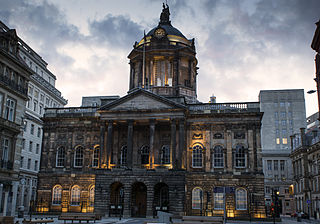
Liverpool Town Hall stands in High Street at its junction with Dale Street, Castle Street, and Water Street in Liverpool, Merseyside, England. It is recorded in the National Heritage List for England as a designated Grade I listed building, and described in the list as "one of the finest surviving 18th-century town halls". The authors of the Buildings of England series refer to its "magnificent scale", and consider it to be "probably the grandest ...suite of civic rooms in the country", and "an outstanding and complete example of late Georgian decoration".

Tower Buildings is a former office block in the city of Liverpool, Merseyside, England. It stands with its longer front on the east side of the Strand, and extends round the corner into Water Street. The building is located directly opposite the Royal Liver Building, which was designed by the same architect. Earlier buildings on the site have been a sandstone mansion, and a later fortified house known as the Tower of Liverpool. After this was demolished in 1819, it was replaced in 1846 by the first structure to be named Tower Buildings. The present structure is one of the earliest steel-framed buildings in England, and details of its architecture reflect the earlier fortified building on the site. It is a building
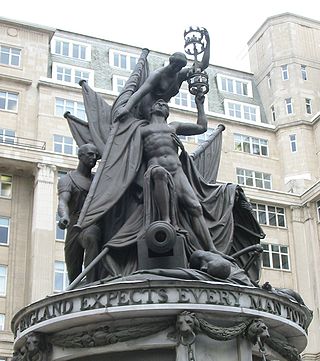
The Nelson Monument is a monument to Admiral Horatio Nelson, in Exchange Flags, Liverpool, England. It was designed by Matthew Cotes Wyatt and sculpted by Richard Westmacott. It stands to the north of the Town Hall and was unveiled in 1813.

A blast shelter is a place where people can go to protect themselves from blasts and explosions, like those from bombs, or in hazardous worksites, such as on oil and gas refineries or petrochemical facilities. It differs from a fallout shelter, in that its main purpose is to protect from shock waves and overpressure instead of from radioactive precipitation, as a fallout shelter does. It is also possible for a shelter to protect from both blasts and fallout.

Admiral Sir Percy Lockhart Harnam Noble, GBE, KCB, CVO was a Royal Navy officer who served in both World Wars.
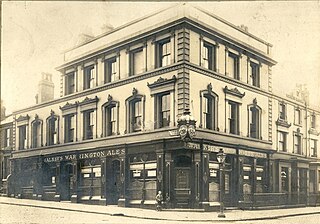
The Royal Park Hotel was a three storey, handsome public house and hotel situated on the corner of Admiral Street and North Hill Street, Toxteth, Liverpool, England. It was built in the 1860s1 as a three-storey building possibly by the brewer Walkers of Warrington. A long bar ran the length of the pub curving at the end; two other rooms had no bar and were served by waiter service, which disappeared towards the end of the pub's life. The name of the pub probably refers to the fact that Toxteth was a Royal Park - although in the interwar years the name changed to the Admiral Hotel.2 In the 1871 England Census, it is recorded as being at 2 Admiral Street, Toxteth Park and in Ordnance Survey maps of the period it is marked as a PH on the corner of Admiral Street and North Hill Street - with a Freemasons' hall adjacent to it at 80 North Hill Street. However, in some Censuses the hotel is recorded as being at 84 North Hill Street.

The architecture of Liverpool is rooted in the city's development into a major port of the British Empire. It encompasses a variety of architectural styles of the past 300 years, while next to nothing remains of its medieval structures which would have dated back as far as the 13th century. Erected 1716–18, Bluecoat Chambers is supposed to be the oldest surviving building in central Liverpool.

The Weavers' Triangle is an area of Burnley in Lancashire, England consisting mostly of 19th-century industrial buildings at the western side of town centre clustered around the Leeds and Liverpool Canal. The area has significant historic interest as the cotton mills and associated buildings encapsulate the social and economic development of the town and its weaving industry. From the 1980s, the area has been the focus of major redevelopment efforts.

The Mersey Match Factory, later known as The Matchworks, is a former match factory on Speke Road, Garston, Liverpool, England. The factory closed in 1994, and has since been converted into offices and workshops. It had opened in 1921, having been built for Maguire, Paterson and Palmer, and later used by Bryant and May. The factory was the first building in the United Kingdom to be constructed using the flat-slab concrete technique. It is recorded in the National Heritage List for England as a designated Grade II listed building.

Maryborough Base Hospital is a heritage-listed hospital at Walker Street, Maryborough, Fraser Coast Region, Queensland, Australia. It was designed by Queensland Colonial Architect John James Clark and built from 1887 by Robert Taylor. It is also known as Maryborough General Hospital. It was added to the Queensland Heritage Register on 2 February 1998.
The Batterie Mirus is located in Saint Peter and Saint Saviour, Guernsey. Originally called Batterie Nina, it comprised four 30.5 cm guns. The battery was constructed from November 1941 and through the first half of 1942, and was the largest battery in the Channel Islands, the guns having a maximum range of 51 km. Although the guns were removed in the early 1950s, the reinforced concrete structures and associated positions remain intact.

Corn exchanges are distinct buildings which were originally created as a venue for corn merchants to meet and arrange pricing with farmers for the sale of wheat, barley, and other corn crops. The word "corn" in British English denotes all cereal grains, such as wheat and barley. With the repeal of the Corn Laws in 1846, a large number of corn exchanges were built in England, particularly in the corn-growing areas of Eastern England.
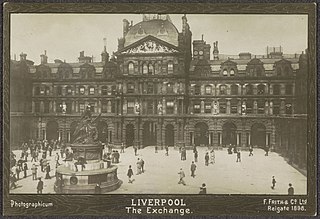
Exchange Buildings was a Victorian building designed by Thomas Henry Wyatt in French Renaissance style. It had been built (1864–67) on Exchange Flags in Liverpool, England. It was demolished and replaced by the current building in 1939.

Exchange Buildings was a large classical style office building by John Foster Sr. possibly a joint work with James Wyatt, demolished and replaced 1864–67 by a building of the same name in French Renaissance style by Thomas Henry Wyatt.
